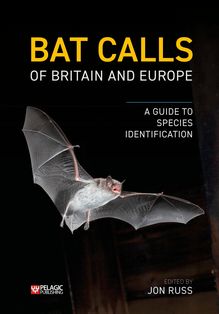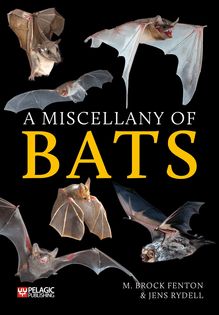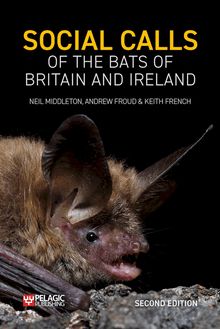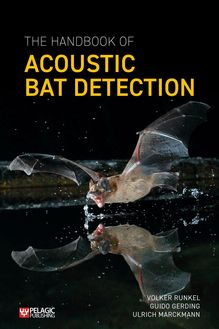-
 Univers
Univers
-
 Ebooks
Ebooks
-
 Livres audio
Livres audio
-
 Presse
Presse
-
 Podcasts
Podcasts
-
 BD
BD
-
 Documents
Documents
-
- Cours
- Révisions
- Ressources pédagogiques
- Sciences de l’éducation
- Manuels scolaires
- Langues
- Travaux de classe
- Annales de BEP
- Etudes supérieures
- Maternelle et primaire
- Fiches de lecture
- Orientation scolaire
- Méthodologie
- Corrigés de devoir
- Annales d’examens et concours
- Annales du bac
- Annales du brevet
- Rapports de stage
La lecture à portée de main
Vous pourrez modifier la taille du texte de cet ouvrage
Découvre YouScribe en t'inscrivant gratuitement
Je m'inscrisSocial Calls of the Bats of Britain and Ireland , livre ebook
Découvre YouScribe en t'inscrivant gratuitement
Je m'inscrisEn savoir plus
Vous pourrez modifier la taille du texte de cet ouvrage
En savoir plus

Description
The social calls of bats are an area about which relatively little is known, with more research still required to expand our understanding. However, these calls are increasingly recognised as a useful aid to identification: they appear to be species specific and are indicative of behaviour – as in territorial activity of males during the mating season. Because the gathering and interpretation of bat echolocation data are a matter of course during research, conservation and consultancy, it is a logical progression to build momentum behind the consideration of social calls in mainstream bat-related work. A better understanding of this subject could mean that non-intrusive survey methods are developed, ensuring that what is being observed is, as far as possible, purely natural behaviour. In turn this will contribute to better interpretation and more suitable mitigation, compensation and/or enhancement solutions.
The book summarises what is understood so far about social calls of the bat species occurring in Britain and Ireland, and north-west Europe. This new edition has been updated and expanded throughout, now containing:
- foreword by the bat authority Michel Barataud, author of Acoustic Ecology of European Bats
- almost double the number of figures and tables as appeared in the first edition
- completely overhauled call library, all in full spectrum format, with new additional examples
- three entirely new chapters, covering bat-related acoustics, settings for social interaction, and survey guidelines
The material will be useful to people carrying out bat studies, at whatever level and for whatever purpose, and will also encourage others to undertake further research. What's more, social calls are fascinating to listen to: they are, after all, produced with listeners in mind (other bats). In light of this, the book is accompanied by an extensive downloadable library of sound files which offer a unique gateway into the private life of bats.
Foreword
Preface
Acknowledgements
About the Authors
Important Notices
1 An Overview of Bats in Britain and Ireland
2 Bat-related Acoustics: An Introduction
3 Settings for Social Interaction
4 Classification of Social Calls
5 Analysis of Social Calls
6 Considerations in Survey Design
7 Survey Guidelines (Bat Social Calls)
8 Species Groups
Appendix
Bibliography
References
Index
Sujets
Informations
| Publié par | Pelagic Publishing |
| Date de parution | 26 juillet 2022 |
| Nombre de lectures | 0 |
| EAN13 | 9781784273798 |
| Langue | English |
| Poids de l'ouvrage | 4 Mo |
Informations légales : prix de location à la page 0,2700€. Cette information est donnée uniquement à titre indicatif conformément à la législation en vigueur.
Extrait
Social Calls of the Bats of Britain and Ireland
Social Calls of the Bats of Britain and Ireland
expanded and updated second edition
Neil Middleton
Andrew Froud
Keith French
PELAGIC PUBLISHING
First published in 2022 by Pelagic Publishing 20–22 Wenlock Road London N1 7GU, UK
www.pelagicpublishing.com
Social Calls of the Bats of Britain and Ireland (second edition)
Copyright © Neil Middleton, Andrew Froud and Keith French 2022
All photographs © the respective photographers as listed
The moral rights of the authors have been asserted in accordance with the Copyright, Designs and Patents Act 1988.
All rights reserved. Apart from short excerpts for use in research or for reviews, no part of this document may be printed or reproduced, stored in a retrieval system, or transmitted in any form or by any means, electronic, mechanical, photocopying, recording, now known or hereafter invented or otherwise without prior permission from the publisher.
British Library Cataloguing in Publication Data
A catalogue record for this book is available from the British Library
https://doi.org/10.53061/OELT7442
ISBN 978-1-78427-378-1 Paperback ISBN 978-1-78427-379-8 ePub ISBN 978-1-78427-380-4 PDF
Cover images: Bechstein’s bat Myotis bechsteinii © Laura Torrent, naturamontfred.com
Contents
Foreword
Preface
Acknowledgements
About the Authors
Important Notices
1. An Overview of Bats in Britain and Ireland
2. Bat-related Acoustics: An Introduction
3. Settings for Social Interaction
4. Classification of Social Calls
5. Analysis of Social Calls
6. Considerations in Survey Design
7. Survey Guidelines (Bat Social Calls)
8. Species Groups
8.1 Introduction and overview of species profiles
8.2 Rhinolophus species
8.3 Myotis species
8.4 Nyctalus species
8.5 Vespertilio species
8.6 Pipistrellus species
8.7 Eptesicus species
8.8 Plecotus species
8.9 Barbastella species
Appendix: Genus/Species-Specific Considerations
Bibliography
References
Index
Foreword
By Michel Barataud
Bat researcher and author of
Acoustic Ecology of European Bats: Species Identification and Studies of Their Habitats and Foraging Behaviour
For more than thirty years, research into the subject of acoustics as applied to bats has grown considerably, allowing numerous inventories and ecological studies to be carried out, with echolocation having received the lion’s share of this knowledge process.
The field of acoustic communication for social purposes is still full of grey areas. However, beyond their complementary role to sonar signals for the purpose of acoustic identification, social calls provide a better understanding of the richness of interactions within this order of mammals, whose social organisation appears to be very elaborate.
There are many circumstances in which social calls are exchanged in the life of a bat: in daytime roosts (between adults, and between mothers and their young); in foraging areas (inter- and intra-specific, with an agonistic or, on the contrary, cooperative aim); within mating territories (autumn swarming locations, advertisement sites, territorial boundaries), and so on.
When one observes the complexity of certain social behaviours within a bat maternity colony (such as grooming or cooperative suckling in Myotis bechsteinii ), one can only suspect that the use of acoustics is just as sophisticated. It now seems obvious that the acoustic repertoire of bats is even more diversified in the social domain than in that of echolocation. Moreover, there is a fine line between these two categories. It is becoming increasingly evident that many species use signals with a dual function, without it always being possible to disentangle the relative importance of each. As such, any stone added to the edifice of our knowledge deserves to be saluted.
The first edition of Neil, Andrew and Keith’s book in 2014 was welcomed by bioacoustic chiropterists, as they have very few bibliographic sources in order to compare their field-collected sequences with a reference catalogue. The first edition also deserves to be praised for the thoroughness shown by the authors, and for its synthesis illustrated with modern means (e.g. FFT analyses, downloadable sound files).
This second, revised and expanded, edition continues the momentum, and ensures that this fine team continues a meritorious effort towards improved knowledge. As a user of this book, I have noticed some significant new material. Most parts of the book have been amended with additional information, with the former Chapter 2 now occupying the more richly detailed Chapters 2 and 3 , and the addition of the highly relevant Chapter 7 about survey guidelines, associated with Appendix 1 (also downloadable as a PDF). The species accounts are even more detailed (text, spectrograms, sounds), sometimes enriched, for example, by comparisons with rodent sounds to avoid confusion. The book is still presented as a catalogue, but with a general classification of social call types by behaviour and by structure.
The known repertoire of social calls in European bats is constantly expanding and becoming more complex; this diversity of structures makes it very difficult to present them in the form of a dichotomous key, which would facilitate identification work but could also lead to misleading simplifications. An analogical comparison, thanks to the numerous annotated figures and sound sequences, remains a more reliable solution at this incomplete stage of our knowledge.
With time, we will undoubtedly be better able to link each social emission with a more or less precise behaviour, and this will open up further the field of investigation to the ethological domain. The desire to know, as well as we are able, the reasons behind sounds created in the natural world of bats, is not only at the heart of scientific research, but also at the heart of our natural curiosity, which is our constant driving force. Thus, this new book can only be received with interest by ‘bat detectives’.
And finally, if I may, a few personal remarks. The exchanges I have had with Neil show him to have both technical and human qualities, which is never negligible in a world where science tends to be more and more separated from the emotional. As for Andrew and Keith, the link they have with Epping Forest reminds me of a high point for me in rock culture, the Genesis album Selling England by the Pound , * and testifies to their own ‘battle’ to achieve the best!
Michel Barataud December 2021 (Originally prepared in French; translated by Aileen Hendry)
* Track 5 of this album, entitled ‘The Battle of Epping Forest’
Preface
It’s been a while since the first edition of this book was published (in 2014). To be honest, back then we were unsure how well received it would be. Thankfully, we have been truly humbled by the positive reaction created by the work, and it certainly seems to have helped to put bat social calls at the forefront of people’s minds more often. Did we ever expect, or intend, for there to be a second edition? At the time – definitely not. We didn’t feel overly competent and comfortable doing it the first time around. So, to imagine putting ourselves through the process again would have certainly been in direct conflict with the ‘thank goodness that’s all over’ , post-delivery relief we experienced, in advance of the stressful months ahead waiting for that first book to hit the shelves and for us to deal with any reaction.
But, oh, how life has changed. The journey we have been on since then has by all accounts been unanticipated, and a bit of a rollercoaster. Workshops, presentations, training courses and of course not forgetting the two Social Calls of Bats conferences we hosted in 2016 (London) and 2018 (Edinburgh), attended by well over 200 delegates, including many of the ‘great and the good’ in bat bioacoustics. And that takes us to early 2020, when the phone rang. It was Nigel at Pelagic Publishing: “Hey guys, are you up for a second edition?” The reaction from our team was initially mixed, to say the least, but the carefully considered answer had to be “Most definitely, let’s do it.”
In agreeing to do this, however, we felt that there was little benefit in merely updating some text and adding a few new calls. We knew we had a great deal more that we could have said in the first edition. So many more examples and thoughts. And of course, adding to this, in the intervening period we never stopped gathering data, helped hugely by countless correspondents sending us recordings.
What’s different in this new edition? There are many new examples within the species descriptions, with most of the calls available from the call library, which is now in Full Spectrum format (previously Time Expansion), making these, broadly speaking, more in line with the software people are using today. We have also included more information about matters such as survey considerations ( Chapter 6 ), as well as specific survey guidelines for social calls ( Chapter 7 ). Furthermore, the academic world continues to produce significant findings, advancing knowledge; thus, the large number of references we had initially could be expanded. Therefore, anyone with the first edition will find lots of new ‘stuff’ the second time around: many of the examples initially used have been replaced, thus widening considerably the material available for reference purposes. So, don’t throw away or ignore your first edition, as that combined with what is produced here gives you a substantial resource.
The social calls of bats continue to be an area about which relatively little is known, with more research required in order to verify what is already thought to be understood, and to explore further our knowledge and understanding of this subject. We are often asked to explain the value of studying bat social calls. In short, they are becoming increasingly recognised as a good aid to identi
-
 Univers
Univers
-
 Ebooks
Ebooks
-
 Livres audio
Livres audio
-
 Presse
Presse
-
 Podcasts
Podcasts
-
 BD
BD
-
 Documents
Documents
-
Jeunesse
-
Littérature
-
Ressources professionnelles
-
Santé et bien-être
-
Savoirs
-
Education
-
Loisirs et hobbies
-
Art, musique et cinéma
-
Actualité et débat de société
-
Jeunesse
-
Littérature
-
Ressources professionnelles
-
Santé et bien-être
-
Savoirs
-
Education
-
Loisirs et hobbies
-
Art, musique et cinéma
-
Actualité et débat de société
-
Actualités
-
Lifestyle
-
Presse jeunesse
-
Presse professionnelle
-
Pratique
-
Presse sportive
-
Presse internationale
-
Culture & Médias
-
Action et Aventures
-
Science-fiction et Fantasy
-
Société
-
Jeunesse
-
Littérature
-
Ressources professionnelles
-
Santé et bien-être
-
Savoirs
-
Education
-
Loisirs et hobbies
-
Art, musique et cinéma
-
Actualité et débat de société
- Cours
- Révisions
- Ressources pédagogiques
- Sciences de l’éducation
- Manuels scolaires
- Langues
- Travaux de classe
- Annales de BEP
- Etudes supérieures
- Maternelle et primaire
- Fiches de lecture
- Orientation scolaire
- Méthodologie
- Corrigés de devoir
- Annales d’examens et concours
- Annales du bac
- Annales du brevet
- Rapports de stage










